Liberty Avenue is one of the stations on the Pitkin Subway Extension of the Fulton Street Line that opened just after World War II on November 28, 1948. It was a unfished shell during the war that couldn't be finished because of material shortages from the war effort. This meant the station got a very unusual tile job and design for the mezzanine compared to the rest of the IND local stations.
The station's one mezzanine is right in the middle of the station and is accessed by two fairly narrow staircases that form parallel to the platform. The mezzanine itself is extremely narrow by IND standards. On it a fence runs down the center-allowing there to be a free transfer between directions with the turnstiles in the middle. Opposite the turnstiles is the token booth and three staircases up to street level, up to all four corners of the intersection of Liberty Avenue and Pennsylvania Avenue (some of them have underground passageways that meander a bit to get to their actual exit.
The station walls have larger than normal basic tiles with a cream color. The name tablets have white text on a blue background with a lighter blue boarder. The station also has the trim that is standard for an IND station, two full light blue tiles with a half-tile blue boarder. White text and dark purple tile spell out Liberty below the station's trim. On the mezzanine there is also original tiling for a Public Telephone above an indentation in the wall that no longer has phones in it, Boro Hall and Manhattan is tiled for. For the other platform there is another incident of tiling for a destination that the subway was never extended too: Richmond Hill, a neighborhood a bit north of Ozone Park, the current terminus, below this Lefferts Blvd has been painted on, over some other tiling that probably said some other even deeper into Queens Destination.
Photos 1-15: May 29, 2009;
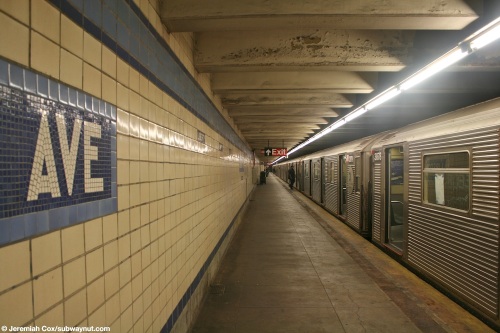
Looking down the Manhattan-bound side platform at Liberty Avenue as a R32 C makes it's station stop.
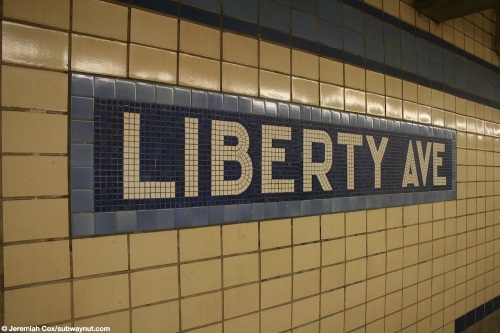
A Liberty Ave name tablet.
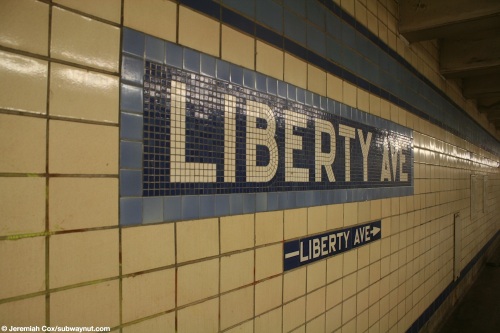
A Liberty Ave name tablet with the directional arrow below it for the next to Liberty Ave.

Approaching the center of the Manhattan-bound platform at Liberty Ave, where the area is that has the two narrow staircases up to the mezzanine area and station exit, the platform doubles in width here for the staircases, and there are a couple of tiled station columns.
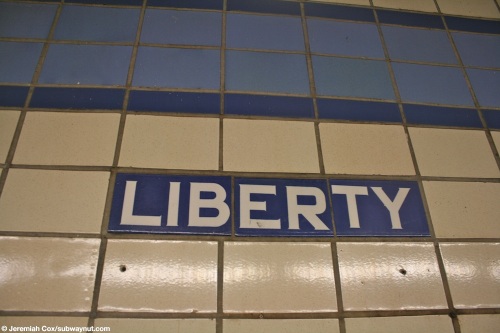
The Liberty White text on blue-purple tiling beneath the station's trim.
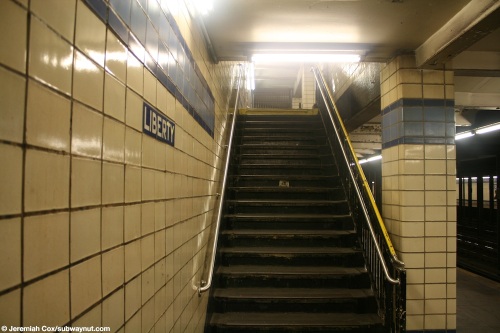
One the two staircases up to the mezzanine level from the Manhattan-bound platform at Liberty Avenue, notice how modern metal banisters have supplemented the unusual looking original ones.
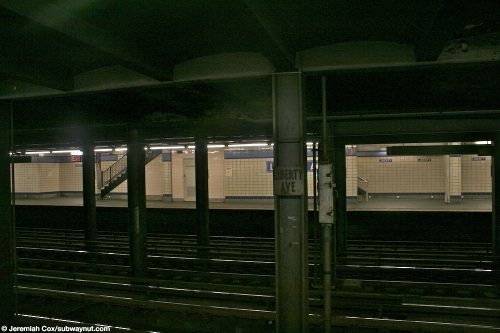
Looking across the four track subway line at Liberty Avenue, the Euclid Av-bound platform is clearly visible, along with a Liberty Ave sign on a support column.

Original tiling at the top of the two platform staircases where they meet on the mezzanine spelling out 'Boro Hall and Manhattan'.
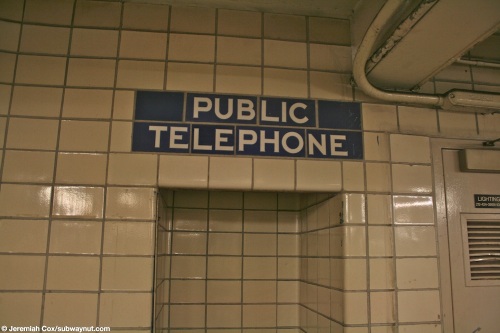
A tiled sign that says Public Telephones above a small indentation in wall where a phone probably was once upon a time, this sign is currently meaningless.
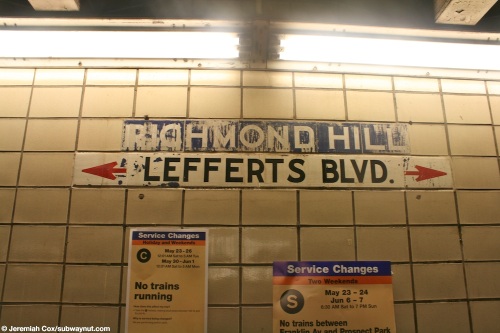
The tiled signs above the two staircases to the Euclid Avenue-bound station are another example of signs for destinations the subway hasn't really reached, the top one is tiled for Richmond Hill, although it looks like all the paint that was ment to say something else has chipped off. The bottom sign is correct but has been painted on over tiles and says Lefferts Blvd.
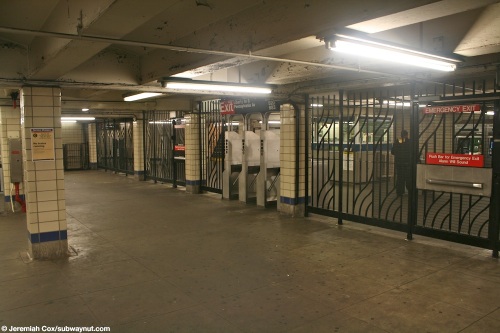
The adequate but not far too large mezzanine area within fare control at liberty Ave.
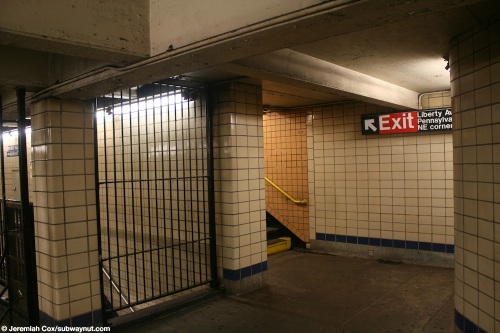
Approaching one of the staircases up to street level at Liberty Av.
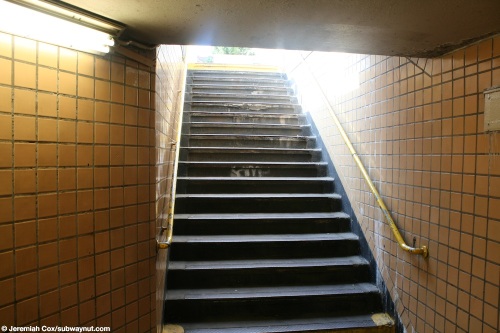
A staircase from street level to the mezzanine at liberty Av, typical of most subway stations.
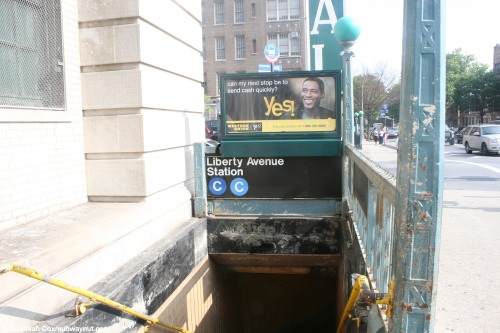
One of the sidewalk exits from Liberty Avenue. The service bullets on this sign has to Cs for some reason, completely incorrect.
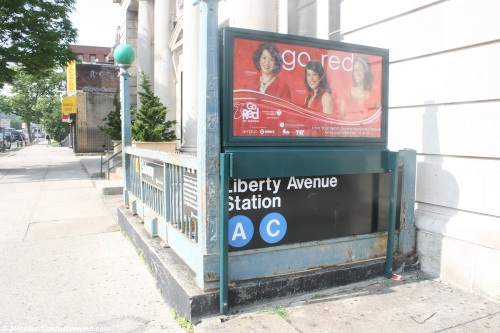
Another sidewalk entrance to Liberty Avenue says both the A and C still serve the station, this is leftover from before 1998, when the C started running to Brooklyn at all times except late nights, not terminating at World Trade Center on weekends, like it did than. Usually trains that stop only during late nights aren't publicized except in the fine print of platform service times signs.
Last Updated: March 16, 2023
This website is not allifiated with MTA New York City Transit, their official website is here
This Website is maintained and copyright © 2004-2025, Jeremiah Cox. This website is not affiliated with any transit provider. Please do not remote link images or copy them from this website without permission.














